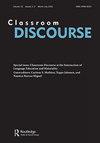A case study of two South Korean middle school EFL teachers’ practices: instructional stances and use of classroom materials
IF 1.6
Q2 EDUCATION & EDUCATIONAL RESEARCH
引用次数: 2
Abstract
ABSTRACT This case study uses a sociocultural theoretical perspective to examine how two Korean middle-school EFL teachers nurtured participatory affordances for their students through classroom discourse. We conducted a triangulated analysis of video-recorded classroom discourse, observational notes and teacher interviews. Our findings show how the teachers’ instructional stances, namely orientations to teaching, were linked to their use of materials and their interactional practices. While Ms. Yoon’s instructional stance was undergirded by a focus on grammatical accuracy, Ms. Jin’s stance was student-centred, driven by her desire to make English-language learning meaningful. The teachers’ instructional stances, in turn, fundamentally shaped their discursive strategies, their uses of L2 materials, and the learning opportunities these produced for students. Using decontextualised examples, Ms. Yoon relied on a rapid-paced Initiation-Response-Evaluation (IRE) pattern, positioning students as knowledge-receivers. By contrast, Ms. Jin enacted more dialogic interaction using meaningful intertextual links and playful talk, which resulted in students’ active participation, evidenced by their initiation of topics and extended answers. Our study contributes to nascent classroom-based research on L2 material use by suggesting two additional areas for research: the link between teacher instructional stance and L2 material use and intertextual links as a mediational tool for learning.以韩国两位中学英语教师为例:教学立场与教材使用
摘要本案例研究运用社会文化理论的视角,考察了两位韩国中学英语教师如何通过课堂话语培养学生的参与性启示。我们对课堂话语录像、观察笔记和教师访谈进行了三角分析。我们的研究结果表明,教师的教学立场,即教学取向,是如何与他们对材料的使用和互动实践联系在一起的。尹女士的教学立场是注重语法的准确性,而金女士的教学立场是以学生为中心的,她希望让英语学习变得有意义。反过来,教师的教学立场从根本上塑造了他们的话语策略,他们对第二语言材料的使用,以及这些为学生提供的学习机会。尹女士使用了脱离语境的例子,采用了快节奏的发起-反应-评估(IRE)模式,将学生定位为知识的接受者。相比之下,金老师通过有意义的互文链接和有趣的谈话进行了更多的对话互动,这使得学生们积极参与,从他们发起话题和扩展答案中可以看出。我们的研究为新兴的基于课堂的第二语言材料使用研究做出了贡献,提出了两个额外的研究领域:教师教学立场与第二语言材料使用之间的联系,以及作为学习中介工具的互文联系。
本文章由计算机程序翻译,如有差异,请以英文原文为准。
求助全文
约1分钟内获得全文
求助全文

 求助内容:
求助内容: 应助结果提醒方式:
应助结果提醒方式:


